Art Shapiro stands on the edge of a Chevron gas station in the north-central Sierra, sipping a large Pepsi and scanning the landscape for butterflies.
So far he’s spotted six species — a loping Western tiger swallowtail, two fluttering California tortoiseshells, a copper-colored common checkered-skipper, a powdery echo blue, a rusty-looking Nelson’s hairstreak and a brown Propertius duskywing.
And that was while waiting for his ride to finish up in the restroom.
Shapiro jots the names of each species on a white note card, then tucks it into his T-shirt pocket stuffed with three pens, one Sharpie, a glasses case and newspaper clippings.
It’s not a bad showing for a gas station at 7,000 feet, he says, climbing back into the car. Last year was abysmal for butterflies in California. For the first time in his life, he didn’t see one single monarch caterpillar all summer long. This casual count at the rest stop indicates that 2019 will be better. But Shapiro isn’t celebrating yet.
“Short-term fluctuations may or may not contain messages about longer-term trends,” he says. And the long-term trends are clear: In California, the butterflies are disappearing.
Shapiro, 73, is a professor of evolution and ecology at UC Davis and a collector of many things: quotes, books, names and stories. Particular interests include Argentinian politics, hermetic texts, meteorology and cheap beer. His specialty, however, is butterflies.
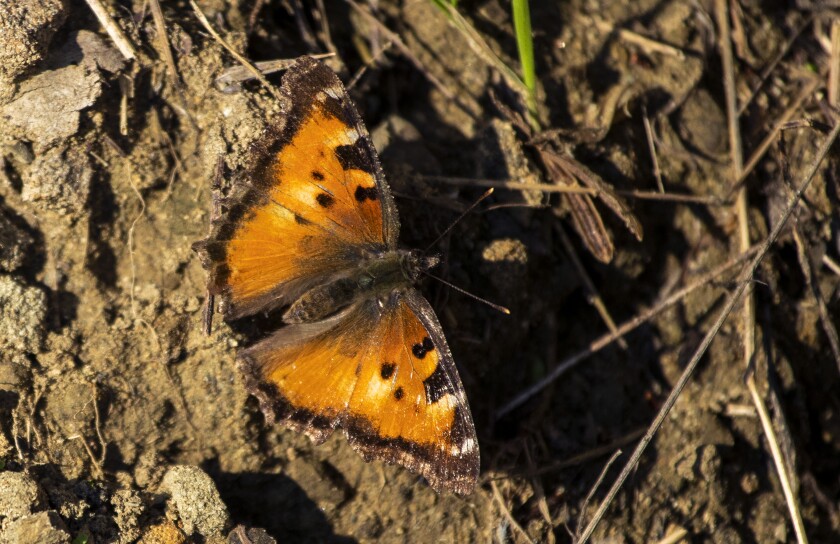
A California tortoiseshell butterfly sits on a mud flat in Gates Canyon near Vacaville, Calif.
For nearly half a century he has meticulously tracked butterfly populations at 10 sites in north-central California, visiting each location every two weeks as long as the weather permits.
In that time he has single-handedly created the longest-running butterfly monitoring project in North America.
“It was originally designed as a five-year project, but the data were too good to stop collecting them,” he says. “And here I am, 47 years later.”
The protocol, for decades, has been unchanged and simple: Record and identify every butterfly he sees.
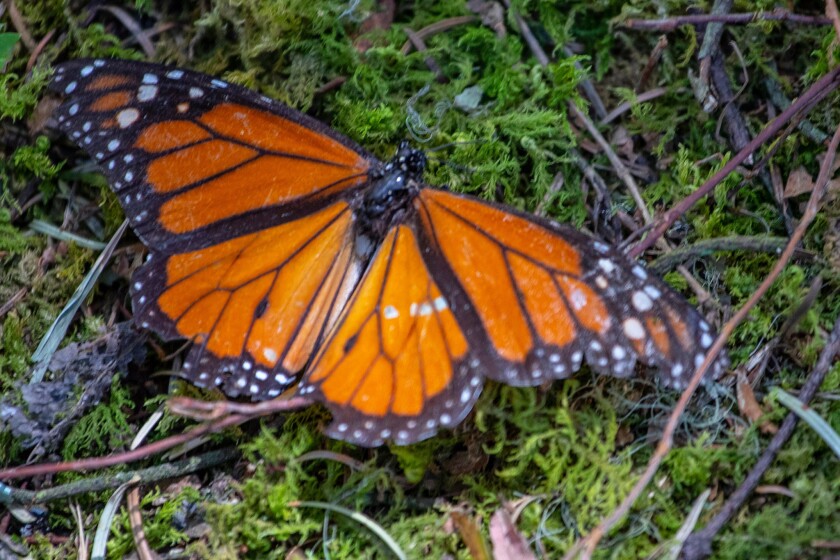
“It’s completely incomprehensible, the whole thing,” says Matt Forister, an ecologist who studied with Shapiro before starting his own lab at the University of Nevada in Reno. “Nobody visits 10 sites every two weeks for that long. It is unheard of in the history of science.”
Shapiro does not carry a cellphone because he doesn’t like distractions. He doesn’t drive because he doesn’t like the person he is behind the wheel. He still prints out articles he’s read to share with his wife. Each week he changes the quote that appears on the bottom of his email.
Shapiro spends about 260 days a year in the field — and he looks like it. His skin is tan and creased. His gray hair sticks straight up like a lion’s mane, a sizable white beard obscures the lower half of his face. His gait is a bit stiffer than it was five years ago, but he can still walk 15 miles in a day, no problem.
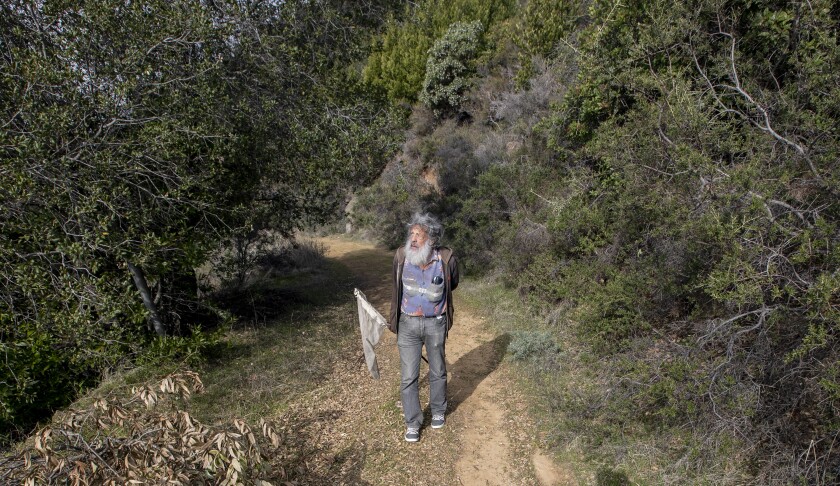
Shapiro, 73, is a collector of many things: quotes, books, names and stories.
He first started tracking butterflies as a 10-year-old desperate to escape an unhappy home in Philadelphia in the 1950s. At the time, his family lived in the last row of houses at the northwest edge of the city. Nature began across the street.
His bible was the “Field Book of Insects” by Frank Lutz. It was small enough to fit in a large pocketed field jacket and included dozens of detailed color plates.
When he was about 14, he switched to the “Peterson Field Guide to the Eastern Butterfly.” His original copy lies buried somewhere in his office, hidden among piles of books, clippings, postcards and papers.
Shapiro thought up his audacious butterfly project in the 1960s as an undergrad at the University of Pennsylvania. The idea was to select sites with varying climate, elevation, topography and vegetation and then track the butterflies in each location for five years.
The question he originally hoped to answer was how changes in temperature and precipitation influence when different species emerge from a pupa or hatch as eggs.
Butterflies are not the only insects that go through a dramatic metamorphosis, but they may be the most well-studied.
Even so, as recently as 50 years ago scientists weren’t sure how this transformation occurred, but in the last few decades researchers learned that between the caterpillar and adult stage the animal’s body liquefies inside the pupa and then reorganizes itself to form the butterfly. Only the nervous system stays intact.
“You can’t second-guess evolution any more than you can second-guess God,” Shapiro says.
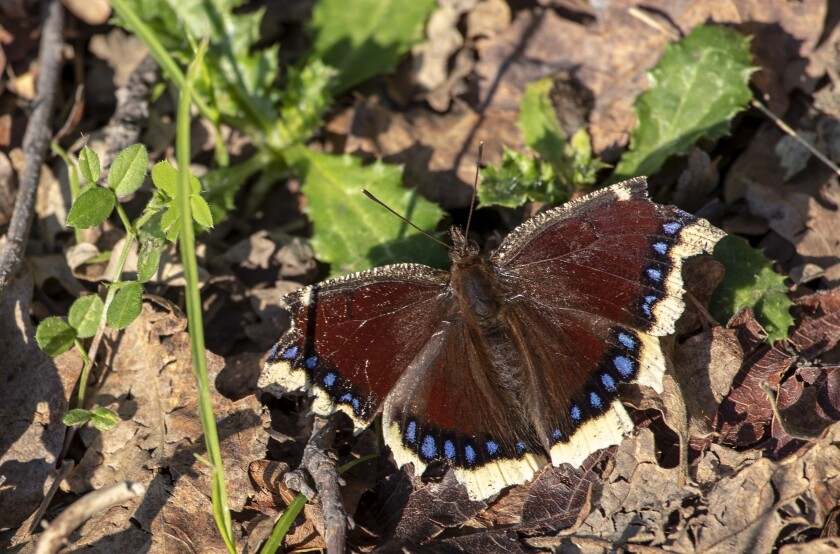
A Mourning cloak butterfly sits on a pile of leaves in Gates Canyon near Vacaville, Calif.
Shapiro will gladly expand on all kinds of topics, but he seems to have trouble articulating why butterflies fascinated him as a boy and why he still studies them today.
After one pitcher of beer at G Street Wunderbar, a university hangout in Davis, he responds to the question “Why butterflies?” with another question: “Why not?”
After a second pitcher of beer, he is more loose. “I don’t know. It probably had to do with whether or not I was breastfed as a baby.”
Shapiro sees his life as a series of lucky accidents. He was recruited to join the faculty of UC Davis in 1971 by a biologist who was chatting up his wife at a cocktail party.
“My wife was, and still is, a very attractive woman,” Shapiro says. (He first got her attention by showing her a moth he had in his pocket.)
Before moving to Davis, the couple lived in Staten Island, where Shapiro taught ecology at the City University of New York. He had been to California only one time before,to visit a friend in L.A.
Once he arrived he immersed himself in California ecology. He traveled widely, studied geological maps and statistical abstracts of climate. He read all the literature he could find on local vegetation.
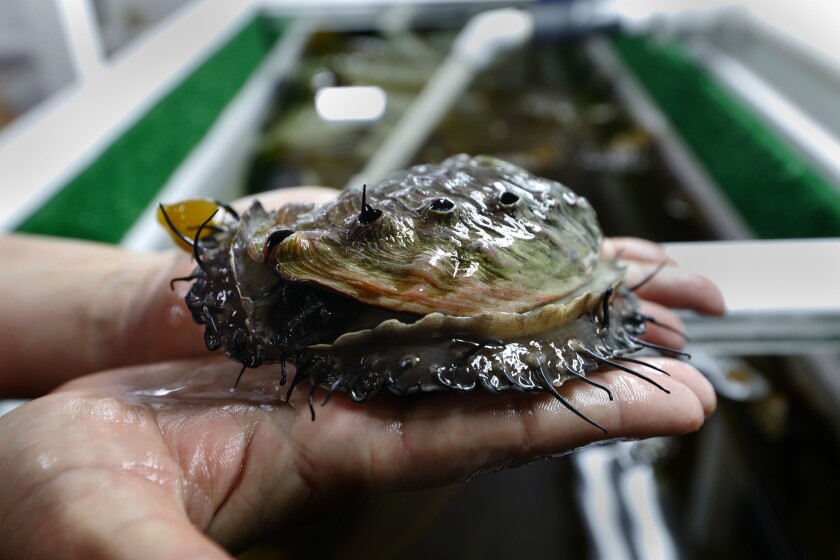
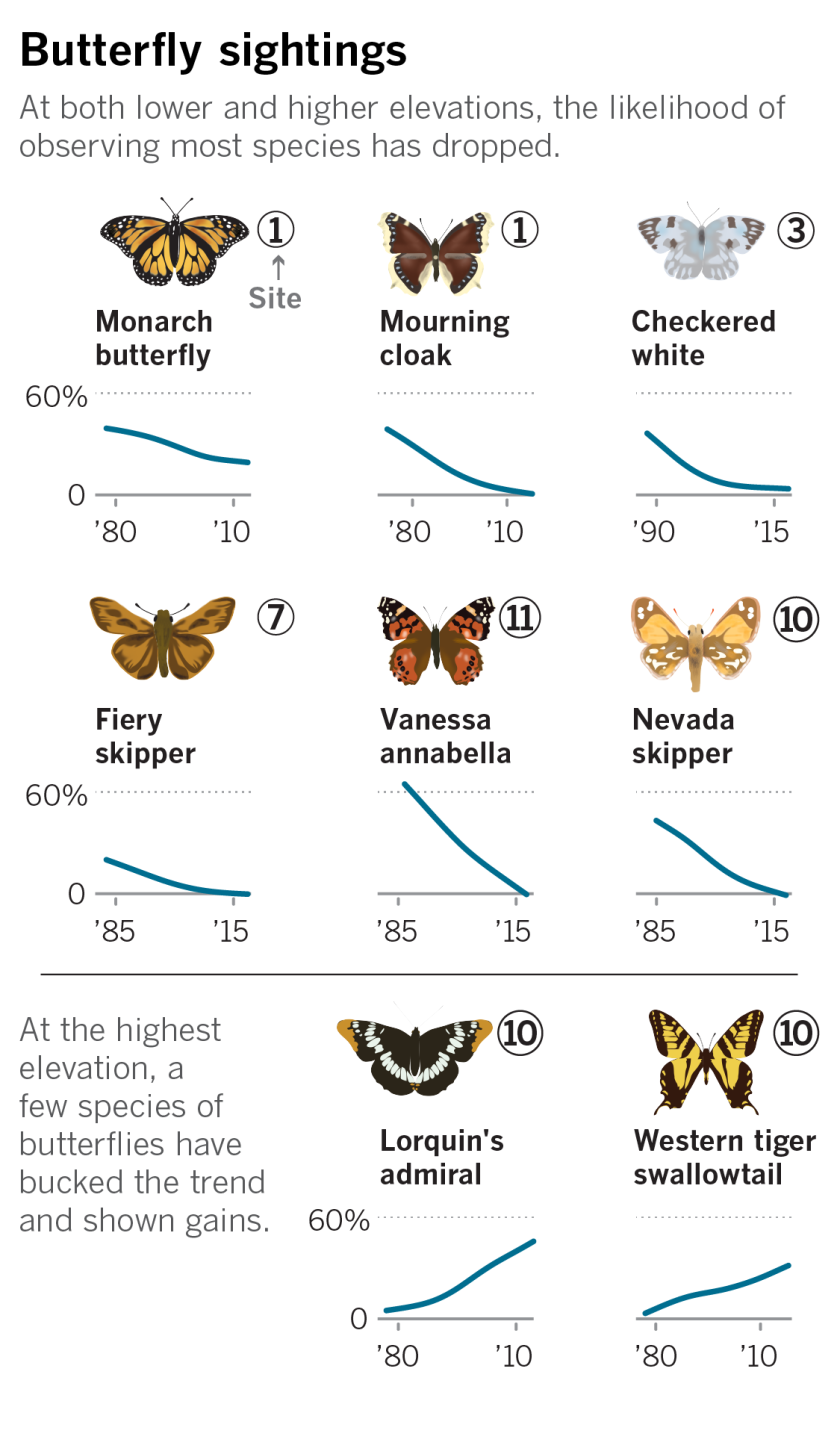
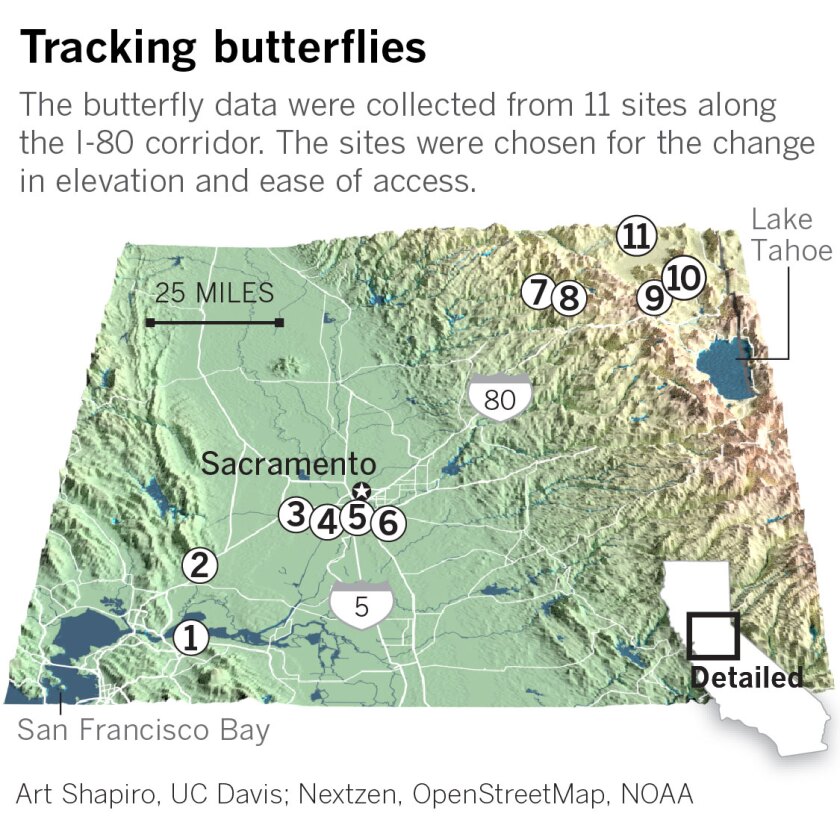
Once again, he got lucky. The climate around Sacramento had recently shifted from a period of relative stability to one of extreme variability. Under this new weather regime, a wet year might deliver 36 inches of rain; a dry year could yield just 6 inches.
“I thought, my God — thank you, Jesus! — because this is the kind of place that is going to give me data that are ideal for my statistical purposes,” he says. “I wanted a lot of variation and I got it.”
By 1972, he had selected five sites that met his study criteria: a high biodiversity of plant and butterfly species, a nearby weather station, slim chances of being developed in the coming decades, and differing habitat and elevation. They also were all accessible by public transportation.
In the last 47 years, Shapiro has gotten to know many of the locals at his study sites, thanks to his frequent trips and affinity for cold beers in dark bars.
While hunting for butterflies in a site overlooking the infamous Donner Pass, he directs his ride to pull into the parking lot of the Donner Summit Historical Society Museum.
The museum’s founder, Norm Sayler, ambles across the street to say hello.
“I was just telling someone I hadn’t seen the good professor yet this year,” he says. “How are you doing?”
“Compared to who?” Shapiro says.

In the last 47 years, Shapiro has gotten to know many of the locals at his butterfly study sites, thanks to his frequent trips and affinity for cold beers in dark bars.
After purchasing a book from the museum store to add to his enormous collection, Shapiro stops at another location just off the Pacific Crest Trail. Here at 7,700 feet, the air is especially clear and the world looks as if it was rendered in high definition.
Shapiro climbs slowly over the rocky landscape. His quarry: a brown elfin butterfly.
“We’re looking for something that’s about the size of your thumbnail” he says, peering into a patch of low-growing huckleberry oak.
And then he sees them: Two copper-colored butterflies flitting around each other in chaotic circles. It’s either a mating ritual or a territorial battle.
“Oh, we’re in luck,” he says, pulling out the white note card again. He adds “brown elfin” to his list and looks up, pleased.
That makes 26 species of butterflies he’s seen today.
Shapiro’s monitoring study was designed to focus on fluctuations on very short timescales — what scientists call noise. But as he kept monitoring the same sites decade after decade, a disturbing long-term trend emerged in his data.
Without a doubt, the overall abundance of butterflies was declining.
‘You can’t second-guess evolution any more than you can second-guess God.’
ART SHAPIRO
He didn’t notice it at first. Insect populations are volatile, plummeting in years when weather conditions are unfavorable and, because they can reproduce so quickly, rising when conditions are just right.
But in 1999, 27 years after Shapiro started monitoring his sites, something strange happened: the populations of 17 species of butterflies at his low-elevation sites tumbled all at once.
“That got my attention,” he says. “We had never had so many species go down at the same time before. And we began to look at long-term trends more carefully as a result.”
What he and his colleagues found is that if you eliminate the noise from his data, the number of butterflies had decreased significantly at these sites from when he first started his project.
In recent years it has gotten much worse. Forister, who does much of the statistical analysis of Shapiro’s data, said that back in the 1970s, Shapiro would regularly see 30 species at some of his sites. Today he is more likely to find 20.
Shapiro says 2018 was the worst butterfly season he ever experienced. The number of species across all elevations was down, something he had never seen before.
As a scientist, Shapiro knew this catastrophic count provided a valuable data point. The abysmal numbers could help other researchers understand how to make sense of future plunges in butterfly populations and perhaps help them pinpoint the culprit. But as a person who has spent his whole life among butterflies, he could not help but feel morose.
“One does not rejoice when one’s system is going away,” he says.
He told friends and colleagues that he felt like a physician who had known a patient for the patient’s entire life. Now the patient was obviously dying and he had no idea why.
Scientists who study butterfly populations blame a suite of factors for their decline, including loss of open spaces, changing agricultural practices and growing use of pesticides on farms and in home gardens. Statistical analysis also suggests that climate change has had an impact as well.
Shapiro’s educated hunch is that a group of pesticides known as neonicotinoids has played a significant role in the waning of populations, but he can’t be sure.
“The 1998-1999 season corresponded to widespread neonic use,” he says. “But we only have the correlation. We can’t prove it.”
So what now?
Shapiro is in excellent health, but he can’t monitor the butterflies forever.
Public transportation to his sites has become more limited over the years, so he started recruiting student assistants to drive him to some of the more out-of-the-way locations, and serve as an extra pair of eyes.
“My vision is not improving with age,” he says.
A couple of years ago, he turned over his highest-elevation site to one of Forister’s graduate students. Hiking up the incline wasn’t a problem, but going down was wreaking havoc on his knees.
“Getting old is a pisser, but it beats the alternative,” he says.
There is no obvious successor to this work, and Shapiro says it is unlikely that other researchers could feasibly monitor his sites with the same consistency.
Forister and a handful of Shapiro’s other former students are working out how to keep the long-term data set going. One idea is to have an overlapping stream of graduate students take on his sites, each one training the next.
But it won’t be quite the same.
“The remarkable thing about Art’s data is that he did it, he did all of it,” Forister said. “I can’t do that. Honestly, I don’t know how he did that.”
For now, Shapiro has no plans to retire. His family’s medical history suggests he will drop dead by 83 if not sooner, he says.
And if that happens when he is out in the field, that would suit him just fine.
 Home Of Ghana News Ghana News, Entertainment And More
Home Of Ghana News Ghana News, Entertainment And More





